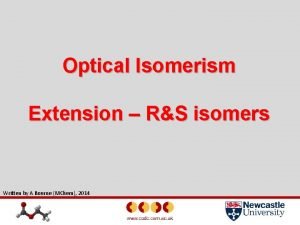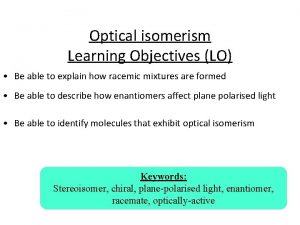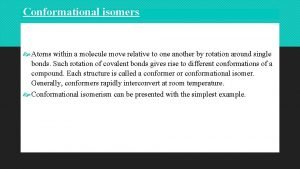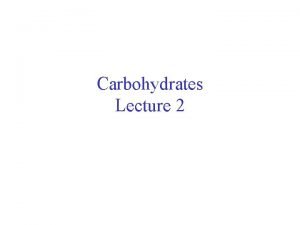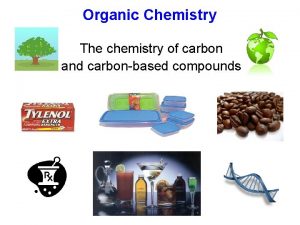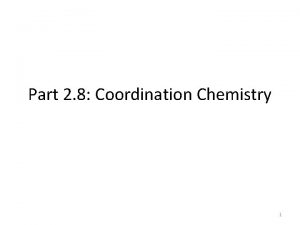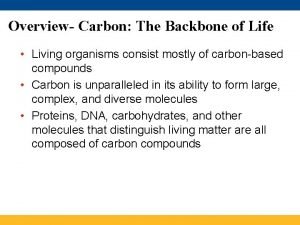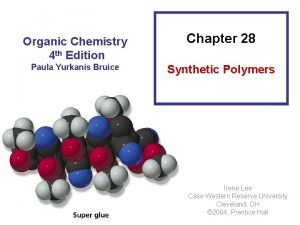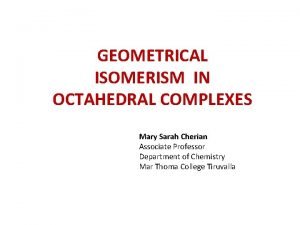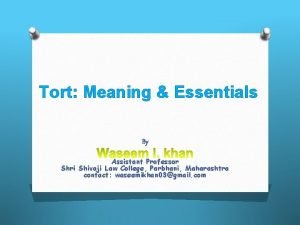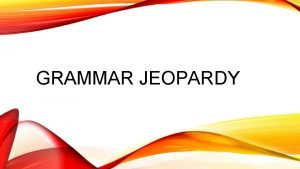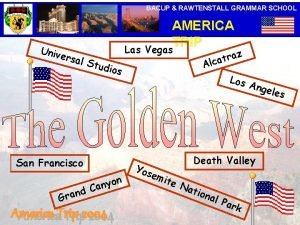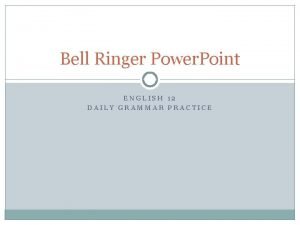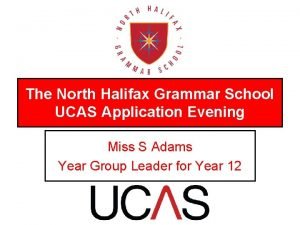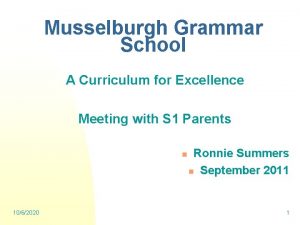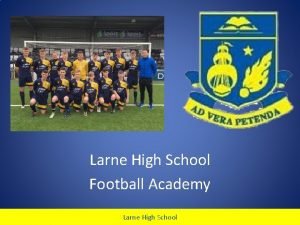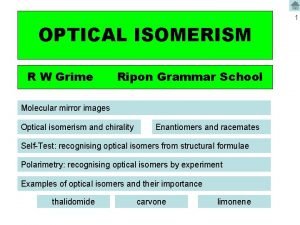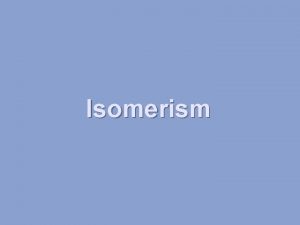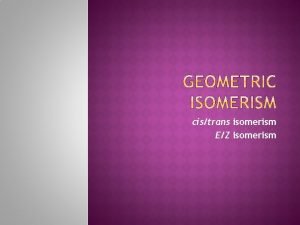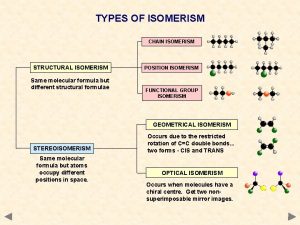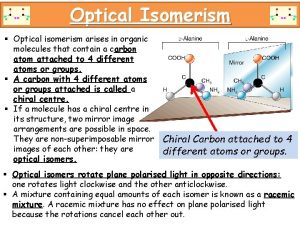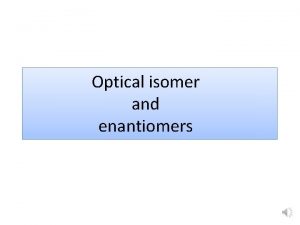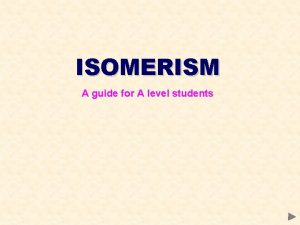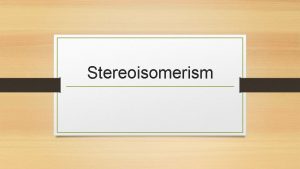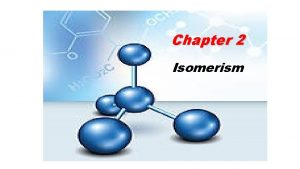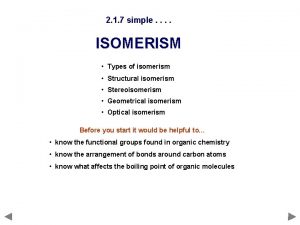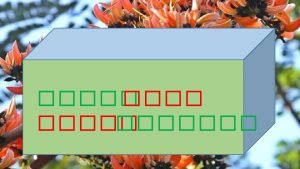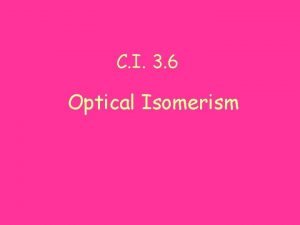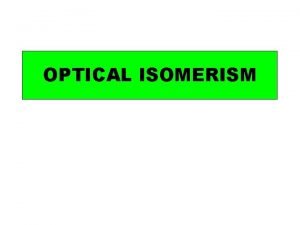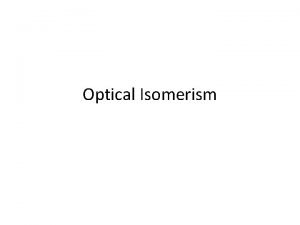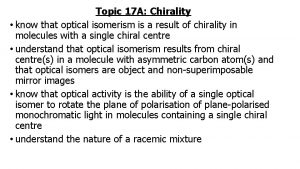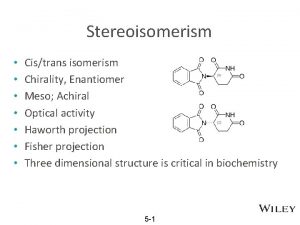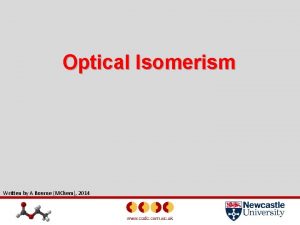OPTICAL ISOMERISM R W Grime Ripon Grammar School






























- Slides: 30

OPTICAL ISOMERISM R W Grime Ripon Grammar School

• All molecules have a mirror image – but for most molecules it is the same molecule.

• For some molecules the mirror image is a different molecule (the mirror image is non-superimposable).


• Left and right hands are an example of non-superimposable mirror images.

• This usually happens when a molecule contains a C atom with four different groups attached (chiral / asymmetric C). • Such molecules are said to be chiral or optically active.

• The optical isomers are called enantiomers. • These are distinguished by +/-, D/L or more correctly R/S. • A 50/50 mixture of the two enantiomers is called a racemic mixture or a racemate.

TASK Which of the following molecules are optically active? 1) 2) 3) 4) propan-2 -ol 2 -chlorobutane 1 -chlorobutane 3 -methylhexane 5) 6) 7) 8) butanone 2 -methylbutanoic acid butan-2 -ol 1 -chloro-3 -methylpentane

propan-2 -ol NOT OPTICALLY ACTIVE

2 -chlorobutane OPTICALLY ACTIVE

1 -chlorobutane NOT OPTICALLY ACTIVE

3 -methylhexane OPTICALLY ACTIVE

butanone NOT OPTICALLY ACTIVE

propan-2 -ol NOT OPTICALLY ACTIVE

2 -methylbutanoic acid OPTICALLY ACTIVE

butan-2 -ol OPTICALLY ACTIVE

1 -chloro-3 -methylpentane OPTICALLY ACTIVE

• Molecules that are optical isomers are called enantiomers. • Enantiomers have identical chemical and physical properties, except: • Their effect on plane polarised light; • Their reaction with other chiral molecules

• The wave vibrations are perpendicular to the direction of travel of the wave.

• Optical isomers rotate the plane of plane polarised light.


Optical activity of enantiomers Plane of polarization Direction of light Optically active substance If they are enantiomers, they have same specific rotation but to different direction. Plane of polarization Direction of light Optically active substance

• Chiral molecules often react differently with other chiral molecules. • This is like the idea that a right hand does not fit a left handed glove – the molecule must be the correct shape to fit the molecule it is reacting with. • Many natural molecules are chiral and most natural reactions are affected by optical isomerism.

• For example, most amino acids (and so proteins) are chiral, along with many other molecules. • In nature, only one optical isomer occurs (e. g. all natural amino acids are rotate polarised light to the left).

• Many drugs are optically active, with one enantiomer only having the beneficial effect. • In the case of some drugs, the other enantiomer can even be harmful, e. g. thalidomide.

• In the 1960’s thalidomide was given to pregnant women to reduce the effects of morning sickness. • This led to many disabilities in babies and early deaths in many cases.

S thalidomide (effective drug) The body racemises each enantiomer, so even pure S is dangerous as it converts to R in the body. R thalidomide (dangerous drug)

• Thalidomide was banned worldwide when the effects were discovered. • However, it is starting to be used again to treat leprosy and HIV. • Its use is restricted though and patients have to have a pregnancy test first (women!) and use two forms of contraception (if sexually active).

S carvone (caraway seed) Caraway Seed has a warm, pungent, slightly bitter flavour with aniseed overtones. R carvone (spearmint)

S limonene (lemons) R limonene (oranges)
 2-hydroxypropanenitrile displays optical isomerism
2-hydroxypropanenitrile displays optical isomerism Slidetodoc.com
Slidetodoc.com Optical isomerism worksheet
Optical isomerism worksheet Abstract classes in java
Abstract classes in java Duotrio pokemon
Duotrio pokemon R-strategist definition
R-strategist definition Local guide program
Local guide program Ripon wisconsin
Ripon wisconsin Cycloalkenes
Cycloalkenes Conformations
Conformations L-monosaccharide structure
L-monosaccharide structure 2-methylpentane isomers
2-methylpentane isomers Ligand field strength order
Ligand field strength order Structural isomer
Structural isomer Polymerization isomerism
Polymerization isomerism Geometrical isomerism
Geometrical isomerism Linear grammar
Linear grammar Traditional grammar vs modern linguistics
Traditional grammar vs modern linguistics Chomsky hierarchy
Chomsky hierarchy Right linear grammar to left linear grammar
Right linear grammar to left linear grammar Gloucester grammar school case
Gloucester grammar school case Paisley grammar school tie
Paisley grammar school tie 8th grade ela warm ups
8th grade ela warm ups Grammar jeopardy middle school
Grammar jeopardy middle school Alison murison
Alison murison Bingley grammar school
Bingley grammar school Bacup and rawtenstall grammar school
Bacup and rawtenstall grammar school English 12 grammar
English 12 grammar Pschee
Pschee Musselburgh grammar school
Musselburgh grammar school Larne grammar school pe kit
Larne grammar school pe kit


